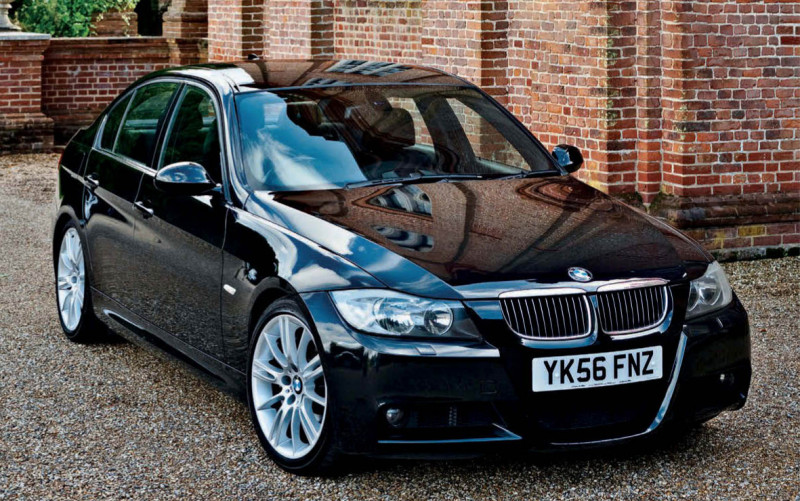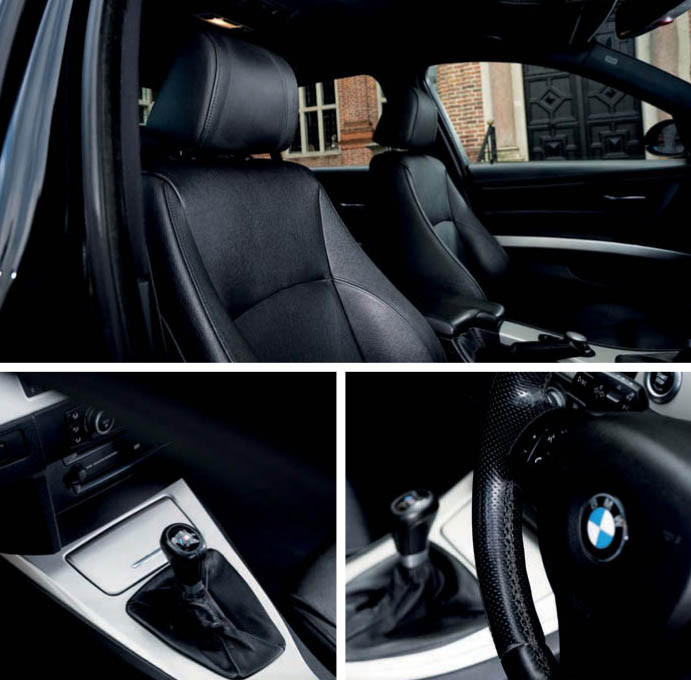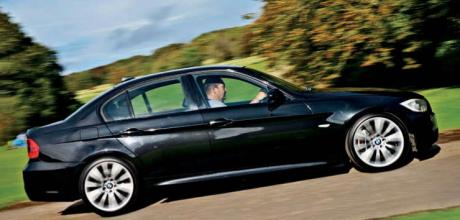2010 BMW 335i Manual E90
With prices of the E9x M3 spiralling into the stratosphere, the 335i could be a savvy way to scratch the itch. With practicality, classy understated styling and that peachy twin-turbo straight-six, is there anything not to like?
Words: Graham Leigh
Photography: Jason Dodd
2010 E90 335i Affordable 3 Series

BMW are masters of the Halo car. Uncompromising M cars are the ones that get tongues wagging, the press gushing superlatives and kids blu tacking posters to their walls. It’s a formula that has worked well for decades with some of that cool trickling down the range and helping sales figures. Win on Sunday, sell on Monday and all that. As time goes on, the M hype, if anything, gets stronger and modern classic status is almost guaranteed. For the thinking man, sometimes it pays to look one rung down the ladder. We’re talking E34 535i, E39 540i, E36 328i, E46 330i… you get the picture.

These used cars are a fraction of the cost of their Motorsport range-topping brethren but in the real world offer 95 percent of the fun. Although lacking the pub talk Top Trumps bragging rights, often they can make for more usable road cars. Today, it’s the E90 335i that’s under our spotlight for that very reason.

The 335i was such a subtle package that it could be debadged and blend into the roadside furniture. It’s a car that many need reminding of. Whilst this may have put some would-be punters off in period that wanted something a little more showy, it’s also the car’s party piece as it remains an iron fist in a velvet glove kind of a model and something of a comparative bargain. The price of non-M E9x BMWs is rising but at a much steadier rate of knots than the M3. E9x production ran between 2004 and 2013, £20k is where you need to be to bag a good M3 but what if we told you that the beauty you see on these pages is up for sale with a reputable specialist dealer for just over half that? Well, it is.
Although not the poster car that the M3 was almost guaranteed to be, the 335i represented an important juncture in BMW history as it marked the start of a turbocharged revolution for the company. The first petrol-powered turbocharged production engine it had made in 25-years, to be exact. With previous incarnations of the 3 Series, from a performance point of view, non-M cars were seen as also-rans by some but as time goes on, and tuners push the boundaries of the extremely tunable N54 powerplant, the 335i is moving out from the shadow of its V8 big brother.
The E9x represented a sea change as the DCT (Dual Clutch Transmission) was such a good product that it is as desirable as the manual option on the used market. Shift times, fuel economy and ease of operation created overnight converts in a way that the Sequential Manual Gearbox (SMG) and its electrohydraulic operation just couldn’t muster. The E9x 335i was available with either manual, DCT from 2010 or traditional automatic. The 335i had an engine change during its production. This car is equipped with the N54 twin-turbo straight-six (302hp). Later cars had the single-turbo N55 which, in stock form, boasted the same power as its predecessor.
This article will concentrate on the N54 variant as featured. With the N54 peak power comes along at 5800rpm but importantly the 295lb ft stays constant from 1300rpm up to 5000rpm meaning that low-end grunt always feels plentiful.
The N54 is over-engineered from the factory and takes well to tuning. The engine is often referred to as the “German 2JZ” and is ripe for off-the-shelf enhancements. If tuning is your thing then the 335i may be the one for you. Keen drivers will be disappointed that an LSD wasn’t an option but there are aftermarket options and some owners have retrofitted the E9x M3 LSD.
The E90 feels like a modern car. The power steering has a heavier ‘feel’ engineered into it and there is a neutrality to the handling. Despite the modern feel, it should be remembered that the 335i is moving into modern classic territory as its years advance. Therefore, frequently serviced examples with plenty of bills and stamps in the book are a must and be sure to factor in basic consumables as well as the problem areas identified here. Unless the car is ridiculously cheap, there are enough cherished examples to warrant walking away from ones where your spidy senses just aren’t feeling it.
Given the high-performance nature of these cars, a thorough check for accident damage is a sensible first port of call. An HPI check is a good start but some unscrupulous vendors may have ‘forgotten’ to register an insurance category over the years so keep ‘em peeled and take an expert with you if possible.
The issues with the N54 are usually external to the engine itself. One of the reasons that the N54 is such a popular engine with tuners is that its internals and timing chain system are very robust. The electric water pump and thermostat were a success in terms of a technological step forward. The car warms up faster in winter, it continues running when the car has been switched off to safely cool down the turbos and the associated load on the engine from a traditional mechanical unit is eradicated.
However, The E9x is now at an age where the longevity of the system has been established as its Achilles heel. The water pump will need replacing between 60-80k, thermostats are usually good for a while longer but it’s worth changing the pair together for peace of mind. Factor in £800 for parts. It’s a three-hour job. N54s can suffer from carbon build-up on the intake valves. This is a direct injection side effect as opposed to an E9x specific one. BMW recommends walnut shell blasting the intake valves every 40k. Expect to pay around £350 for a specialist to carry out this process.
If the High-Pressure Fuel Pump (HPFP) hasn’t been replaced with a receipt to prove, for the sake of £200 (plus labour but it’s straightforward for a DIYer), it’s worth addressing. When the HPFP is not at its most efficient it can cause long crank, hesitation and, obviously, breakdown if it fails completely. 335i injectors are now on their fifteenth factory redesign. Intermittent misfire and loss of power are good indicators of issues here. The Oil Filter Housing Gasket (OFHG) can leak internally which creates an oil and coolant mixture or externally which can allow the oil to drop onto the belt drive components. Failing serpentine belts can be an issue due to this leakage, the results of which can be catastrophic. Regular monitoring of this is essential.
The turbos run 8psi on factory settings but can cope with 15psi reliably. However, they’re not without their weaknesses. Wastegate arms can become loose and, in turn, rattle. This can lead to a significant loss of boost. Although replacement/refurbishment for the turbos is now readily available and affordable, the job is labour intensive and includes subframe and downpipe removal.
Now, we were lucky enough to visit Peter Moore, Director of Kent-based Quick and Big, a used car specialist who, as the name suggests, deal in performance and larger vehicles but also anything interesting in the world of modern classics as well as carrying a good stock of cherished private number plates. 50-year-old Peter explained: “It’s the best job in the world. I get to buy, try, and restore the type of modern classics I remember from the last 30-years. When I’ve finished enjoying them, we sell them on to like-minded enthusiasts. It’s fair to say Peter is one of us and has certainly walked the walk from a young age. His driving career started at the tender age of 18 in a beige Mk2 Ford Fiesta that was quickly swapped for a V8 converted Triumph TR7.
This cost him £1600 in insurance. This was in 1989! From this point onwards, Peter tried most of the toys including a Sierra Cosworth, Westfield. Lotus Esprit V8 Twin Turbo, TVR Cerbera 4.5, Honda S2000, Fiat Coupé Turbo, lots of assorted 4x4s including a Range Rover 5.0 Supercharged, and plenty of more family-friendly fare like Volvo V70s etc. All of these were daily drivers but Peter also has a thing for Cosworth-powered kit/track cars. He’s now on his fourth in the shape of a 510hp Dax Rush Quadra. So what about Bavarian metal? Don’t worry, this has been more than represented via an E30 325i Touring, E36 M3 Evo Saloon, E46 M3 Manual Coupé, and various E61 Tourings. Peter missed his old E30 so much that he has just bought another barn find example that he is now restoring. The other BMWs in Peter’s personal BMW collection are an E30 318i parts car, E61 550i M Sport Touring, and an E46 Alpina B3.3 convertible.
Peter was drawn to the featured 2006 E90 335i M Sport Manual Saloon due to its rarity, specification and condition. It’s a 6-speed manual which is particularly rare for a saloon. The car has covered 79k which is backed up by a full service history and old MoTs. It’s got just three former keepers on the logbook, the last of which lavished over £7,000 on maintenance in the last 16,000-miles including the fitment of new turbos. It has been enthusiast owned and was last serviced at 74,373-miles. This example is completely standard, which is becoming increasingly rare.
When new, the original owner paid £37,000, £5000 of that sum was on optional extras. Even by today’s standards, the spec is impressive and includes cruise control with auto brake, twin zone auto climate control, rear temperature control, headlight cleaning system, parking lights, four electric windows, electric heated door mirrors, start/ stop button, condition-based service indicator, auto headlights, voice commands, multifunction steering wheel, rain-sensing wipers, iDrive, widescreen sat nav with disc, ISOFIX mountings, rear park distance control, Premium hi-fi with CD and external input, Bluetooth telephone connectivity, M Sport front seats, rear armrest, M Sport suspension and aero package, Individual Anthracite roof lining, Individual High Gloss shadow line exterior trim, puddle lights and door handle lights. Somebody got busy with the Biro at box-ticking time. The handsome M Sport alloys have been professionally stripped and re-powder coated and are wrapped in matching Bridgestone Run Flats, 225/40/18 (front) and 255/35/18 (rear). Sapphire black metallic with matching Black Dakota full leather is complemented by the aluminium interior pack. Full book packs, wallet, original first aid kit, mats, warning triangle, and two working keys with remote boot release are present and correct and indicative of a car that has been well cared for.
There are a lot of variables here, with coupés, convertibles, saloons and Tourings making up the E9x family, not to mention the choice between manual, automatic and DCT. At the time of writing the cheapest 335i in the classifieds was a 2006 E92 automatic coupé with 176,000-miles for £4450. At the other end of the spectrum, we found a 2013 E91 Touring with just 30,251-miles for £17,999. The majority of good examples seemed to be between £8 and £12K, putting the £10,990 example offered by Quick and Big in the middle of the busiest sector of the market. With the spec, service history and recent big-dollar spend, it looks to be a bit of a bargain. The steady appreciation of the model will offset some of the running costs, making them good investments at this time.
When the E9x M3 was released there was a lot of hyperbole about it being the only car you’ll ever need. A junior supercar you could put the kids in and do the school run in the morning and be at a track day for lunch. Times change though and what we expect of a daily moves on. Granted, the S65 V8 is a peach on the right day, on the right road but as many of us become used to turbocharged technology, it’s the 335i that drives more like a modern car. On the daily grind, the six-cylinder car has more accessible torque, it’s more comfortable and just more refined. The V8’s screaming 414hp maximum power at 8300rpm is an aural treat but the straight-six twin-turbo figure of 302hp at 3900rpm is not to be sniffed at. The aforementioned torque of the 335i is its real superpower though, with the peak 295lb ft being delivered between 1300 and 5000rpm. The M3 has an identical maximum torque reading but it’s only achieved at a comparatively heady 3900rpm. I have firsthand experience with the manual E90 335i as I drove my friends to the Nürburgring a few years back. It ferried us through Europe in comfort and on a technical circuit such as the ‘Ring, that instant glug of torque was welcome and it never felt that the car was being overworked. It really is an underrated delight. Get one now while you still can.
Peter Moore of Quick and Big buys, restores and sells a range of powerful cars like this E90 The torque of the 335i is a real plus point – it peaks at 295lb ft delivered between 1300-5000rpm
The six-cylinder car has more E90 335i M Sport Saloon accessible torque, it’s more comfortable and just more refined…
This particular example is very well specified making it an even more appealing purchase
- ENGINE: 3.0 twin-turbocharged straight-six
- MAX POWER: 302hp
- MAX TORQUE: 295lb ft
- 0-60MPH: 5.4-seconds
- TOP SPEED: 155mph (limited)
- ECONOMY: 20mpg (combined)
- THANKS: quickandbig.com, BMS Dover (independent BMW specialists), Jason Dodd (photographer), Barratts BMW Canterbury Parts Department (for putting up with me), Bushell’s Restoration (classic car restorers par excellence) , Broome Park Hotel and Golf Resort (photoshoot venue)
Despite its modern feel, the 335i is moving into modern classic territory...


